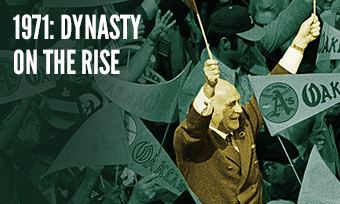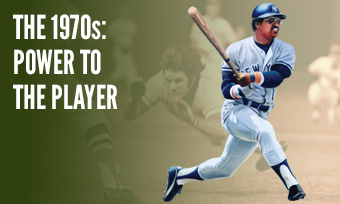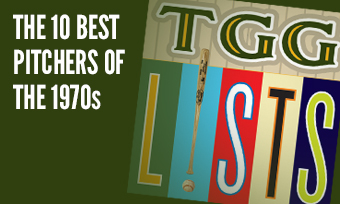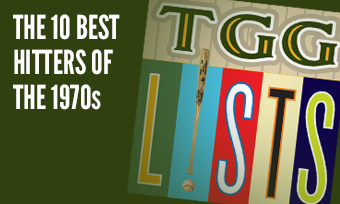The Yearly Reader
Leaders and Honors, 1971
Our list of baseball’s top 10 hitters and pitchers in both the American League and National League for the 1971 baseball season, as well as the awards and honors given to the game’s top achievers of the year.
The National League’s Top 10 Hitters, 1971
Bold type in brick red indicates league leader.
1. Hank Aaron, Atlanta
Key Numbers: 139 games, .327 average, 95 runs, 162 hits, 47 home runs, 118 RBIs, 21 intentional walks, .669 slugging percentage.
Look out, Bambino: Aaron raced past 600 lifetime home runs and belted a career-high 47 at age 37.
2. Joe Torre, St. Louis
Key Numbers: .363 average, 634 at-bats, 97 runs, 230 hits, 34 doubles, 8 triples, 24 home runs, 137 RBIs, 20 intentional walks.
The once-pudgy Torre dieted off the field and feasted on opposing pitchers, setting the tone for a whopper of a season by hitting safely in each of his first 22 games of the year.
3. Willie Stargell, Pittsburgh
Key Numbers: .295 average, 104 runs, 25 doubles, 48 home runs, 125 RBIs, 83 walks, 154 strikeouts, 20 intentional walks.
Stargell promised free chicken from his own fast-food chain every time he hit a homer; 48 blasts later, Pittsburgh’s poultry lovers were yelling fowl. Among Stargell’s power feats were 11 homers in April alone (a major league first), with two hat tricks—both against Atlanta—embedded within that total.
4. Lou Brock, St. Louis
Key Numbers: .313 average, 640 at-bats, 126 runs, 200 hits, 37 doubles, 7 triples, 7 home runs, 61 RBIs, 76 walks, 64 stolen bases, 19 caught stealing.
The Cardinals’ speedster set career highs in runs, walks, hitting streak (26 games) and took back the stolen base crown swiped by Bobby Tolan the year before.
5. Bobby Bonds, San Francisco
Key Numbers: .288 average, 110 runs, 178 hits, 32 doubles, 33 home runs, 102 RBIs, 26 stolen bases.
The dual power/speed threat became the first Giant not named Willie to lead the team in home runs since 1953.
6. Rusty Staub, Montreal
Key Numbers: 162 games, .311 average, 94 runs, 186 hits, 34 doubles, 6 triples, 19 home runs, 97 RBIs, 74 walks.
Staub was second in the NL—and on the Expos—in getting hit by pitches, with nine. The leader, Ron Hunt, had 50.
7. Willie Mays, San Francisco
Key Numbers: 136 games, .271 average, 82 runs, 24 doubles, 5 triples, 18 home runs, 61 RBIs, 112 walks, 23 stolen bases, .425 on-base percentage.
In his last full year in San Francisco, Mays failed to display the usual wowing power numbers—but he walked over 100 times for the first time in his career while showing vintage legs leading to his highest stolen base total since 1960.
8. Billy Williams, Chicago
Key Numbers: .301 average, 86 runs, 179 hits, 27 doubles, 5 triples, 28 home runs, 93 RBIs. 77 walks.
The quiet Cubs star continued to let his bat do the talking, and it was very loud at Wrigley Field—where he batted .347 with a 1.011 OPS (on-base plus slugging percentages).
9. Lee May, Cincinnati
Key Numbers: .278 average, 85 runs, 39 home runs, 98 RBIs.
The 28-year-old slugger finished off a three-year run in which he belted 111 homers; the Reds’ reward was to ship him out to Houston for Joe Morgan.
10. Roberto Clemente, Pittsburgh
Key Numbers: 132 games, .341 average, 82 runs, 178 hits, 29 doubles, 8 triples, 13 home runs, 86 RBIs.
Now in his 17th year with the Pirates, Clemente hit over .340 for the third straight season, although he failed to win a batting title in either year.
The American League’s Top 10 Hitters, 1971
1. Bobby Murcer, New York
Key Numbers: .331 average, 94 runs, 175 hits, 25 doubles, 6 triples, 25 home runs, 94 RBIs, 91 walks, 14 stolen bases, .427 on-base percentage.
Recent-suffering Yankee fans believed, for the moment, that they’d finally found Mickey Mantle’s successor in the historic line of pinstriped icons with Murcer.
2. Roy White, New York
Key Numbers: .292 average, 86 runs, 22 doubles, 7 triples, 19 home runs, 84 RBIs, 86 walks, 14 stolen bases, 17 sacrifice flies.
White’s 17 sac flies set an American League record which still stands today.
3. Don Buford, Baltimore
Key Numbers: 122 games, .290 average, 99 runs, 19 home runs, 54 RBIs, 89 walks, 15 stolen bases.
No one scored 100 or more runs in the American League for only the third time since the Deadball Era, but Buford would have clearly crossed the mark had he not missed 40 games—mostly because of a semi-platoon outfielding scheme by the Orioles. In fact, Buford scored exactly 99 runs for the third straight year.
4. Tony Oliva, Minnesota
Key Numbers: 126 games, .337 average, 164 hits, 30 doubles, 22 home runs, 81 RBIs, .546 slugging percentage.
Oliva copped his third batting title and was hitting as high as .374 in early August thanks in large part to three streaks of at least six games collecting multiple hits; but after a midseason knee injury, followed by offseason surgery—the first of many procedures—he’d never be the same.
5. Norm Cash, Detroit
Key Numbers: 135 games, .283 average, 32 home runs, 91 RBIs.
One last blast from the past for Cash, who at 37 surpassed 30 homers for the first time since 1966; it got him voted into the starting line-up at the All-Star Game at Detroit, but AL manager Earl Weaver refused to start him—preferring his Orioles first baseman, Boog Powell—to an irate cascading of boos from Tiger fans.
6. Merv Rettenmund, Baltimore
Key Numbers: 141 games, .318 average, 81 runs, 11 home runs, 75 RBIs, 87 walks, 15 stolen bases.
Later cited by David Letterman as the best-known pro athlete among his fellow alums at Ball State, Rettenmund thrived in what was strangely his only year among 13 seasons playing every day.
7. Reggie Smith, Boston
Key Numbers: .283 average, 85 runs, 175 hits, 33 doubles, 30 home runs, 96 RBIs, 11 stolen bases.
With Carl Yastrzemski beginning a long-term power outage, Smith stepped in to become the Red Sox’ big bopper.
8. Frank Robinson, Baltimore
Key Numbers: 133 games, .281 average, 82 runs, 28 home runs, 99 RBIs, 72 walks, 22 grounded into double plays.
In his final year at Baltimore before being traded to the Dodgers, Robinson completed the MVP trifecta—winning All-Star Game honors to go with those he’d already collected for the league and World Series. The only other player to win all three is Brooks Robinson.
9. Reggie Jackson, Oakland
Key Numbers: .277 average, 87 runs, 29 doubles, 32 home runs, 80 RBIs, 161 strikeouts, 16 stolen bases.
Jackson improved his batting stance, his confidence (thanks to Winter League manager Frank Robinson in Puerto Rico) and his eyesight—he realized after taking an exam that he was nearsighted—and got back on track after a horrid, strife-torn 1970 campaign. His most famous homer of the year took place at the All-Star Game when he reached Tiger Stadium’s roof.
10. Amos Otis, Kansas City
Key Numbers: .301 average, 80 runs, 167 hits, 26 doubles, 15 home runs, 79 RBIs, 52 stolen bases.
Shipped in from the Mets after he refused to play third base, Otis fit in far more comfortably in the Kansas City outfield; his five steals on September 7 against the Brewers remains a Royals single-game record.
The National League’s Top 10 Pitchers, 1971
1. Tom Seaver, New York
Key Numbers: 1.76 ERA, 20 wins, 10 losses, 35 starts, 21 complete games, 286.1 innings, 61 walks, 289 strikeouts, 24 grounded into double plays.
Seaver was at his most brilliant with career bests in ERA and strikeouts, to say nothing of authoring the NL’s two longest consecutive scoreless-inning streaks in 1971 (31.2 and 27)—and still they gave the Cy Young Award to Ferguson Jenkins, who had four more wins but an ERA one full run higher.
2. Don Sutton, Los Angeles
Key Numbers: 2.54 ERA, 17 wins, 12 losses, 37 starts, 265.1 innings, 55 walks, 20 stolen bases allowed.
After five years of solid if not overpowering results, Sutton found his groove for the long run. Key: Conceding only 10 home runs after giving up 38 the year before.
3. Don Wilson, Houston
Key Numbers: 2.45 ERA, 16 wins, 10 losses, 34 starts, 268 innings.
Not even Tom Seaver had a better opposing batting average than the .202 yielded by Wilson, who thrived in the second half with a 1.42 ERA after July 8.
4. Dave Roberts, San Diego
Key Numbers: 2.10 ERA, 14 wins, 17 losses, 37 appearances, 34 starts, 269.2 innings, 37 grounded into double plays.
The math on Roberts: 2.10 ERA + 14-17 record = life with the sickly Padres offense, which ‘supported’ him with just 2.3 runs per start.
5. Al Downing, Los Angeles
Key Numbers: 2.68 ERA, 20 wins, 9 losses, .690 win percentage, 36 starts, 5 shutouts, 262.1 innings, 12 wild pitches, 26 grounded into double plays.
Downing took a pay cut with the Dodgers to get out of Milwaukee, and got a big raise in results—winning 20 games for his first and only time.
6. Ferguson Jenkins, Chicago
Key Numbers: 2.77 ERA, 24 wins, 13 losses, 39 starts, 30 complete games, 325 innings, 461 total bases allowed, 37 walks, 263 strikeouts, 4 balks.
The Chicago workhorse was an ironic case of one winning the Cy Young Award winner despite leading the league in home runs, doubles and triples allowed.
7. Ken Forsch, Houston
Key Numbers: 2.53 ERA, 8 wins, 8 losses, 33 appearances, 23 starts, 188.1 innings.
The hard-throwing rookie right-hander had to vouch for all of his precious few victories; he won all seven games he went the distance in.
8. Juan Marichal, San Francisco
Key Numbers: 2.94 ERA, 18 wins, 11 losses, 37 starts, 279 innings, 56 walks.
The last productive season for Marichal, who would dive into a relative funk starting in 1972; in hindsight, it was apparent that the Giants traded the wrong ace. (Gaylord Perry would be sent away after the year and win 180 more games.)
9. Steve Blass, Pittsburgh
Key Numbers: 2.85 ERA, 15 wins, 8 losses, 33 starts, 5 shutouts, 240 innings.
The right-hander’s regular season numbers were good enough to almost make one forget about his two complete-game victories in the World Series.
10. Don Gullett, Cincinnati
Key Numbers: 2.66 ERA, 16 wins, 6 losses, .727 win percentage, 35 appearances, 31 starts, 217.2 innings, 25 grounded into double plays.
Though the Reds tripped up in the standings—with their only losing record (79-83) between 1967-81—the second-year Gullett, promoted from the bullpen, put together numbers to suggest the Big Red Machine was in a finely-tuned groove.
The American League’s Top 10 Pitchers, 1971
1. Vida Blue, Oakland
Key Numbers: 1.82 ERA, 24 wins, 8 losses, .750 win percentage, 39 starts, 24 complete games, 8 shutouts, 312 innings, 301 strikeouts, 23 grounded into double plays.
The breakout star of 1971 won the AL Cy Young Award and MVP, striking out more batters than any other A’s pitcher since Rube Waddell’s franchise-best 349 in 1904; though Blue would win 209 games over the next 17 years, he would never again collect even 200 K’s in a season.
2. Wilbur Wood, Chicago
Key Numbers: 1.91 ERA, 22 wins, 13 losses, 44 appearances, 42 starts, 7 shutouts, 334 innings, 62 walks, 27 stolen bases allowed, 24 grounded into double plays.
Wood, warming up to make people forget about Mickey Lolich’s ironman feat (below), showed that he had been wasted as a reliever in the White Sox bullpen.
3. Pat Dobson, Baltimore
Key Numbers: 2.90 ERA, 20 wins, 8 losses, .714 win percentage, 37 starts, 282.1 innings, 63 walks, 28 grounded into double plays.
One of four Orioles to win 20-plus games in 1971, Dobson’s path to the milestone was realized by winning 12 straight starts—all but one of them a complete game—in early summer; he capped his year with a no-hitter for an American All-Star team touring through Japan in November.
4. Mel Stottlemyre, New York
Key Numbers: 2.87 ERA, 16 wins, 12 losses, 35 starts, 7 shutouts, 269.2 innings, 28 grounded into double plays.
The rock of the Yankees rotation sailed along, posting his fifth straight season of at least 15 wins.
5. Mickey Lolich, Detroit
Key Numbers: 2.92 ERA, 25 wins, 14 losses, 45 starts, 29 complete games, 376 innings, 308 strikeouts.
The joke about the hefty Mickey Lolich was that he couldn’t pitch his weight in innings thrown, and some still didn’t think that after he logged an incredible 376 in 1971.
6. Clyde Wright, California
Key Numbers: 2.99 ERA, 16 wins, 17 losses, 37 starts, 276.2 innings, 30 grounded into double plays.
He threw the same number of innings and posted the same exact ERA as teammate Andy Messersmith—and yet he won four fewer games while losing four more. Yet why is he on this list instead of Messersmith? Because he gave up fewer walks, fewer extra-base hits, and induced more double play grounders. Oh, and the Angels offense also gave him one less run of support per start.
7. Mike Cuellar, Baltimore
Key Numbers: 3.08 ERA, 20 wins, 9 losses, .690 win percentage, 38 starts, 292.1 innings, 27 grounded into double plays.
There was nothing more blissful for a deeply superstitious guy like Cuellar than to keep it consistent; as such, he won 20-plus games and pitched just north of 290 innings for the third straight year at Baltimore.
8. Mike Hedlund, Kansas City
Key Numbers: 2.71 ERA, 15 wins, 8 losses, 30 starts, 205.2 innings.
Wrecked apart the year before by a worldwide virus that caused him to lose significant weight, the red-haired, heavily freckled Hedlund was an unsung (and brief) star for the Royals as they clinched their first-ever winning record.
9. Joe Coleman, Detroit
Key Numbers: 3.15 ERA, 20 wins, 9 losses, .690 win percentage, 38 starts, 286 innings, 22 grounded into double plays.
They can put Denny McLain behind them now; along with Lolich, Coleman became half of the first Tigers pitching duo to each win 20 games since 1956; no two Detroit pitchers have done it since.
10. Rudy May, California
Key Numbers: 3.02 ERA, 11 wins, 12 losses, 1 save, 31 starts, 208.1 innings.
Though he’d be more in the spotlight later in the decade with the Orioles and Yankees, May for now was hidden away in the Angels rotation, getting even worse support than Clyde Wright (above); opponents hit just .213 against him, the AL’s third-lowest figure after Vida Blue and Sam McDowell.









